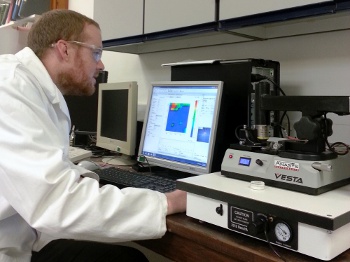Dec 4 2012
Anasys Instruments report on the use of their award-winning nanoscale characterization instrumentation to advance developments in the understanding of drug delivery systems.
 Dr Jonathan Moffat uses the Anasys nano-TA system at UEA.
Dr Jonathan Moffat uses the Anasys nano-TA system at UEA.
The Drug Delivery & Materials Characterization Group at the University of East Anglia, UK, is internationally recognized for work involving the development of novel thermal, dielectric, rheological and microscopic techniques as analytical tools within the pharmaceutical sciences. There is particular emphasis on the study of the physical properties of drugs and dosage forms in relation to performance.
Post-doctoral researcher, Jonathan Moffat, is focused on delivery of poorly water soluble drugs and in particular characterization of delivery systems. His team creates solid dispersions using a variety of different methods which include hot melt extrusion, spray drying and spin coating. Solid dispersions are systems where one or more components are molecularly dispersed in a matrix/carrier. This idea means that if you are able to disperse your drug in a water soluble matrix such as a polymer, then you can improve the dissolution profile and improve the bioavailability of the drug.
The standard characterization methods for these systems include DSC, FTIR and PXRD. Their drawback is that they only provide bulk information. Dr Moffat comments: "As we are analyzing samples consisting of two or more components, we are interested in looking at the distribution, form and at the interface of components. These standard techniques cannot provide this information. Also, the surface of these systems is extremely important as this is the interface between the delivery system and the body. We chose the Anasys nano-TA system as it permits a thorough surface characterization. It is used alongside standard AFM & SEM imaging methods."
Dr Moffat continues: "Whilst these methods can provide high resolution images of the surface of our samples, they cannot provide information on the components within the system. Using nanoTA along with AFM allows the user to pick out features on the surface, interrogate them and subsequently determine the individual component via its transition temperature. As well as determining the component, it is also possible to determine its morphological properties as the transition temperature is sensitive to differences in these properties. This is something that can be difficult to determine with spectroscopic techniques. We also use Transition Temperature Microscopy, TTM, for our samples. This gives a systematic approach to determine the distribution and form of the components and also provides information on how well mixed the systems and whether there is any phase separation."
An example of this work was presented in a poster at the recent AAPS meeting held in Chicago. Dr Moffat's poster presented with co-author, Professor Duncan Craig from UEA, was entitled "Thermal Probe Methods for Nanoscale Characterization of Cyclosporin A Solid Dispersions Prepared by Hot Melt Extrusion."
Kevin Kjoller, Anasys' co-founder and Vice President, says "We're very excited about this new work by Dr Moffat and Professor Craig which potentially opens up a new market for our nanoscale thermal analysis technology." For more details, visit the Anasys Instruments website.